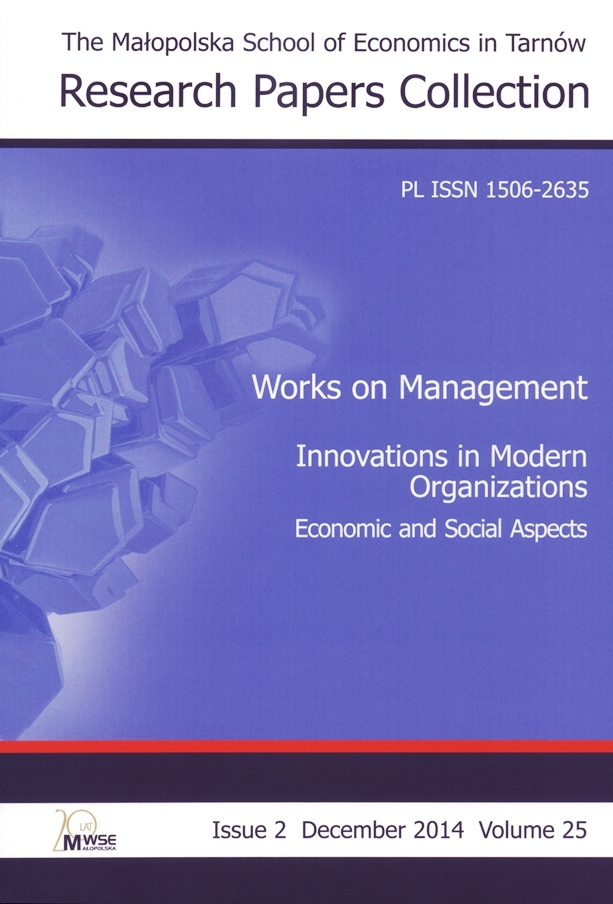Abstrakt
Chcąc zachęcić pracowników do wspólnego wprowadzania innowacji, a tym samym osiągania określonego poziomu przedsiębiorczości na szczeblu całej firmy, menedżerowie powinni wdrażać wartości kulturowe i realizować je poprzez zastosowanie odpowiednich praktyk z zakresu zarządzania zasobami ludzkimi, które wpłyną na psychologiczne podejście do pracowników. W takiej sytuacji wzrośnie wsparcie dla pracowników ze strony przedsiębiorstwa, a to przełoży się na ich zachowania zorientowane na innowacyjność organizacji. Praktyki w dziedzinie zasobów ludzkich mające na celu wspieranie kreatywności i innowacyjności pracowników są dla firmy kluczowe, jeśli chce ona osiągnąć sukces i utrzymywać przewagę konkurencyjną. Celem niniejszej pracy jest określenie zmiennych związanych z kulturą organizacyjną zdolnych do wzmacniania kultury innowacji w przedsiębiorstwie. Uważa się, że umiejętności wprowadzania innowacji można się nauczyć, a sztukę tę doskonalić w procesie rozprzestrzeniania wartości kulturalnych. Ma temu służyć doświadczenie menedżerów w zakresie zarządzania zasobami ludzkimi, pozwalające na osiągnięcie innowacyjnych zachowań wśród pracowników, którzy będą zaangażowani w działania firmy. Zastosowane w niniejszym badaniu metody to analiza i synteza, a także indukcja i dedukcja.
Bibliografia
Ahmed, P. (1998). Culture and climate for innovation. European Journal of Innovation Management, 1 (1), 30–43.
Zobacz w Google Scholar
Amabile, T. M. (1988). A model of creativity and innovation in organizations. Research in Organizational Behavior, 10, 123–167.
Zobacz w Google Scholar
Barney, J. B. (1986). Organizational culture: Can it be a source of sustained competitive advantage? Academy of Management Review, 11 (3), 656–665.
Zobacz w Google Scholar
Çakar, N. D., Erturk, A. (2010). Comparing innovation capability of Small and Medium-Sized Enterprises: Examining the effects of organizational culture and empowerment. Journal of Small Business Management, 48 (3), 325–359.
Zobacz w Google Scholar
Chandler, G. N., Keller, C., Lyon, D. W. (2000). Unraveling the determinants and consequences of an innovation-supportive organizational culture. Entrepreneurship Theory and Practice, 59–76.
Zobacz w Google Scholar
Claver, E., Llopis, J., Garcia, D., Molina, H. (1998). Organizational Culture for Innovation and New Technological Behavior. The Journal of High Technology Management Research, 9 (1), 55–58.
Zobacz w Google Scholar
Covin, J. G., Slevin, D. P. (1991). A conceptual model of entrepreneurship as firm behavior. Entrepreneurship Theory and Practice, 16 (1), 7–25.
Zobacz w Google Scholar
Craig, J. B., Moores, K. (2006). A 10-year longitudinal investigation of strategy, systems, and environment on innovation in family firms. Family Business Review, 19 (1), 1–10.
Zobacz w Google Scholar
Damanpour, F. (1991). Organizational innovation: A meta-analysis of effects of determinants and moderators. Academy of Management Journal, 34 (3), 554–590.
Zobacz w Google Scholar
Day, G. S. (1994). The capabilities of market-driven organization. Journal of Marketing, 58 (4), 37–52.
Zobacz w Google Scholar
Deal, T. E., Kennedy, A. A. (1982). Corporate cultures: The rites and rituals of corporate life. Boston: Addison-Wesley.
Zobacz w Google Scholar
Freeman, J., Engel, J. S. (2007). Models of innovation: Startups and mature corporations. California Management Review, 50 (1), 94–119.
Zobacz w Google Scholar
Gerhart, B. (2009). How much does national culture constrain organizational culture? Management and Organization Review, 5 (2), 241–259.
Zobacz w Google Scholar
Gonzalez-Padron, T., Hult G. T., Calantone, R. (2008). Exploiting innovative opportunities in global purchasing: An assessment of ethical climate and relationship performance. Industrial Marketing Management, 37, 69–82.
Zobacz w Google Scholar
Gudmundson, D., Tower, C. B., Hartman, E. A. (2003). Innovation in small business: Culture and ownership structure do matter. Journal of Developmental Entrepreneurship, 8 (1), 1–17.
Zobacz w Google Scholar
Hauser, M. (1998). Organizational culture and innovativeness of firms: An integrated view. International Journal of Technology Management, 16 (1), 239–255.
Zobacz w Google Scholar
Hofstede, G. (1991). Cultures and organizations: Software of the mind. London: McGraw-Hill. ISBN 0077074742.
Zobacz w Google Scholar
Hurley, R. F., Hult, G. T. (1998). Innovation, market orientation, and organizational learning: An integration and empirical examination. Journal of Marketing, 62 (3), 42–54.
Zobacz w Google Scholar
IBM Global Business Services. (2006). Expanding the innovation horizon: The global CEO study 2006 [online, accessed: 2014-06-16]. Retrieved from: http://www-935.ibm.com/services/au/bcs/html/bcs_ceostudy2006.
Zobacz w Google Scholar
html.
Zobacz w Google Scholar
Kanter, R. M. (2000). A culture of innovation. Executive Excellence, 17 (8), 10–11.
Zobacz w Google Scholar
Leskovar-Spacapan, G., Bastic, M. (2007). Differences in organizations’ innovation capability in transition economy: Internal aspect of the organizations’ strategic orientation. Technovation, 27, 533–546.
Zobacz w Google Scholar
OECD (1997). Oslo Manual: Proposed guidelines for collecting and interpreting technological innovation data. 2nd revised ed. Paris: OECD.
Zobacz w Google Scholar
Ogbonna, E., Harris, L. (2000). Leadership style, organizational culture and performance: Empirical evidence from UK companies. The International Journal of Human Resource Management, 11 (4), 766–788.
Zobacz w Google Scholar
O’Reilly, C. A., Chatman, J., Caldwell, D. F. (1991). People and organizational culture: A profile comparison approach to assessing person-organization fit. Academy of Management Journal, 34 (3), 487–516.
Zobacz w Google Scholar
Slevin, D. P., Covin, J. G. (1990). Juggling entrepreneurial style and organizational structure: How to get your act together. Sloan Management Review, 31 (2), 43–54.
Zobacz w Google Scholar
Snell, S. A. (1992). Control theory in strategic human resource management: The mediating effect of administrative information. Academy of Management Journal, 35 (2), 292–327.
Zobacz w Google Scholar
Wang, S., Guidice, R. M., Tansky, J. W., Wang, Z. (2010). When R&D spending is not enough: The critical role of culture when you really want to innovate. Human Resource Management, 49 (4), 767–792.
Zobacz w Google Scholar
© Copyright by Małopolska Wyższa Szkoła Ekonomiczna w Tarnowie. Artykuły są udostępniane na podstawie Creative Commons Attribution Uznanie autorstwa - Użycie niekomercyjne - Bez utworów zależnych 4.0 Licencja Międzynarodowa


